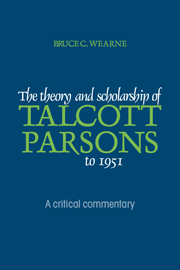Book contents
- Frontmatter
- Contents
- Preface
- Part 1 Unravelling Talcott Parsons' theoretical development
- Part 2 Talcott Parsons: the roots of his thought
- Part 3 The development of theory
- Part 4 The theory
- Part 5 Parsons' theory as it stood at 1951
- Appendix Some recent publishing on Talcott Parsons' theory: a bibliographical essay
- List of references
- Index of names
- Index of Parsonian concepts
Appendix - Some recent publishing on Talcott Parsons' theory: a bibliographical essay
Published online by Cambridge University Press: 05 February 2012
- Frontmatter
- Contents
- Preface
- Part 1 Unravelling Talcott Parsons' theoretical development
- Part 2 Talcott Parsons: the roots of his thought
- Part 3 The development of theory
- Part 4 The theory
- Part 5 Parsons' theory as it stood at 1951
- Appendix Some recent publishing on Talcott Parsons' theory: a bibliographical essay
- List of references
- Index of names
- Index of Parsonian concepts
Summary
Who now reads Talcott Parsons? Recent publishing on Parsons indicates that the former seer of Harvard is maintaining his influence within sociology and throughout the social sciences. It is but ten years since his death at the age of 77 in Munich. The collection compiled by W. Schluchter, Verhalten, Handeln und System: Talcott Parsons Beitrag zur Entwicklung der Sozialwissenschaften (Suhrkamp, 1980) contains Parsons' last public lecture, plus important comments and critical re-examination by Schluchter, Graumann, Luhmann and Habermas. Parsons is still being taken seriously by circles of scholars in the social sciences and related disciplines throughout the world. It is none other than Jurgen Habermas who has stated that ‘any theoretical work in sociology today that failed to take account of Talcott Parsons could not be taken seriously’ (Sociological Inquiry, 51: 3/4 (1981), 174; see further discussion below.
Parsons set forth his own sociological contribution with a clearly formulated distinction between ‘theory’ and philosophical–historical analysis. But ‘action theory’ is now being subjected to philosophical and historical criticism and the Corpus Parsonium is being rediscovered as an important perspective on a number of fronts.
The path-breaking analysis of Parsons' theory was that of Harold J. Bershady, Ideology and Social Knowledge (Blackwell, 1973). This was new and innovative within the North American sociological discipline because it treated the Parsons oeuvre as a body of literature with its own character and integrity.
- Type
- Chapter
- Information
- The Theory and Scholarship of Talcott Parsons to 1951A Critical Commentary, pp. 188 - 194Publisher: Cambridge University PressPrint publication year: 1990



